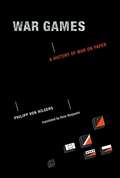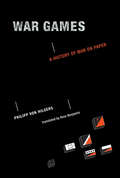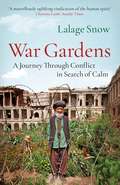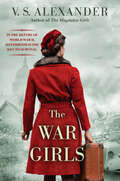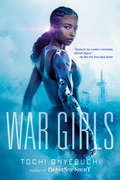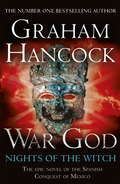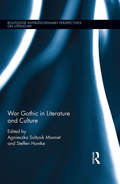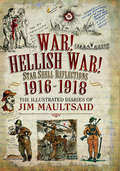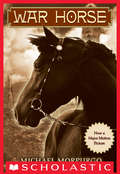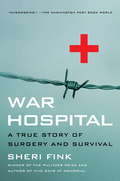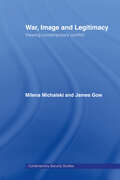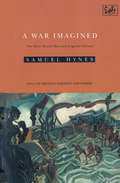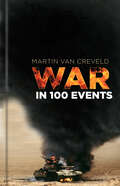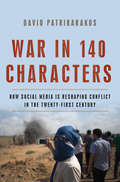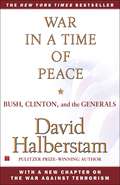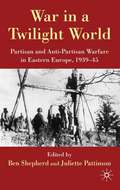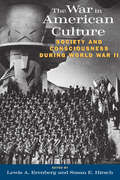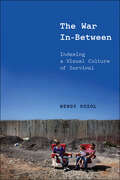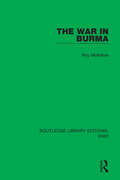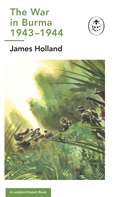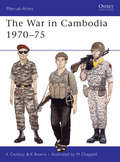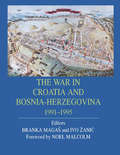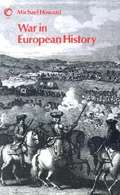- Table View
- List View
War Games: A History of War on Paper
by Philipp Von Hilgers Ross BenjaminFor centuries, both mathematical and military thinkers have used game-like scenarios to test their visions of mastering a complex world through symbolic operations. By the end of World War I, mathematical and military discourse in Germany simultaneously discovered the game as a productive concept. Mathematics and military strategy converged in World War II when mathematicians designed fields of operation. In this book, Philipp von Hilgers examines the theory and practice of war games through history, from the medieval game boards, captured on parchment, to the paper map exercises of the Third Reich. Von Hilgers considers how and why war games came to exist: why mathematical and military thinkers created simulations of one of the most unpredictable human activities on earth. Von Hilgers begins with the medieval rythmomachia, or Battle of Numbers, then reconstructs the ideas about war and games in the baroque period. He investigates the role of George Leopold von Reiswitz's tactical war game in nineteenth-century Prussia and describes the artifact itself: a game board--topped table with drawers for game implements. He explains Clausewitz's emphasis on the "fog of war" and the accompanying element of incalculability, examines the contributions of such thinkers as Clausewitz, Leibniz, Wittgenstein, and von Neumann, and investigates the war games of the German military between the two World Wars. Baudrillard declared this to be the age of simulacra; war games stand contrariwise as simulations that have not been subsumed in absolute virtuality.
War Games: A History of War on Paper (The\mit Press Ser.)
by Philipp Von HilgersThe convergence of military strategy and mathematics in war games, from medieval to modern times.For centuries, both mathematical and military thinkers have used game-like scenarios to test their visions of mastering a complex world through symbolic operations. By the end of World War I, mathematical and military discourse in Germany simultaneously discovered the game as a productive concept. Mathematics and military strategy converged in World War II when mathematicians designed fields of operation. In this book, Philipp von Hilgers examines the theory and practice of war games through history, from the medieval game boards, captured on parchment, to the paper map exercises of the Third Reich. Von Hilgers considers how and why war games came to exist: why mathematical and military thinkers created simulations of one of the most unpredictable human activities on earth.Von Hilgers begins with the medieval rythmomachia, or Battle of Numbers, then reconstructs the ideas about war and games in the baroque period. He investigates the role of George Leopold von Reiswitz's tactical war game in nineteenth-century Prussia and describes the artifact itself: a game board–topped table with drawers for game implements. He explains Clausewitz's emphasis on the “fog of war” and the accompanying element of incalculability, examines the contributions of such thinkers as Clausewitz, Leibniz, Wittgenstein, and von Neumann, and investigates the war games of the German military between the two World Wars. Baudrillard declared this to be the age of simulacra; war games stand contrariwise as simulations that have not been subsumed in absolute virtuality.
War Gardens: A Journey Through Conflict in Search of Calm
by Lalage Snow'A remarkable book . . . It's a powerful testament to the healing balm of gardening and the resilience of the human spirit in the direst of circumstances.' Financial Times'Not a happy book and yet it's magically heartening. It makes a gardener question his or her values.' The Times'This extraordinary book...warm and engaging...like a photograph magicked to life.' Spectator'Snow has spent ten years as a photographer and filmmaker covering unrest . . . Throughout that time she has sought comfort in green oases and come to understand "how vital gardens are 'against a horrid wilderness' of war". . . There can be few counter-narratives as enchanting and sad as those Snow recounts in War Gardens.' Times Literary Supplement'For all these victims of war, their gardens are places in which to breathe, providing moments of calm, hope and optimism in a fragile life of horror and uncertainty. For many, it helps them to grieve. Books seldom bring a lump to my throat, but this one did.' Spectator'What makes War Gardens the most illuminating garden book to be published this year, is the realisation that people's gardens are the antidotes to the horrors of their surroundings.' Country LifeA journey through the most unlikely of gardens: the oases of peace people create in the midst of warIn this millennium, we have become war weary. From Afghanistan to Iraq, from Ukraine to South Sudan and Syria, from Kashmir to the West Bank, conflict is as contagious and poisonous as Japanese knotweed. Living through it are people just like us with ordinary jobs, ordinary pressures and ordinary lives. Against a new landscape of horror and violence it is up to them to maintain a modicum of normality and colour. For some, gardening is the way to achieve this.Working in the world's most dangerous war zones, freelance war correspondent and photographer Lally Snow has often chanced across a very moving sight, a testimony to the triumph of the human spirit in adversity, a celebration of hope and beauty: a war garden. In Kabul, the royal gardens are tended by a centenarian gardener, though the king is long gone; in Camp Bastion, bored soldiers improvise tiny gardens to give themselves a moment's peace; on both sides of the dividing line in Jerusalem families tend groves of olives and raise beautiful plants from the unforgiving, disputed landscape; in Ukraine, families tend their gardens in the middle of a surreal, frozen war.War Gardens is a surprising, tragic and beautiful journey through the darkest places of the modern world, revealing the ways people make time and space for themselves and for nature even in the middle of destruction. Illustrated with Lally Snow's own award-winning photography, this is a book to treasure.
The War Girls: A WW2 Novel of Sisterhood and Survival
by V.S. AlexanderBased on true WWII stories of life in the Warsaw Ghetto during the Occupation and the women who served the Allies as agents and spies, this new historical fiction novel from an acclaimed author is perfect for fans of Kate Quinn, Kristin Harmel, and Pam Jenoff. Casting light into one of the darkest periods of World War II, this powerful book tells of two Jewish sisters– one imprisoned in Poland and the other who joins the Special Operations Executive in a daring attempt to free her family from the Nazis. It&’s not just a thousand miles that separates Hanna Majewski from her younger sister, Stefa. There is another gulf—between the traditional Jewish ways that Hanna chose to leave behind in Warsaw, and her new, independent life in London. But as autumn of 1940 draws near, Germany begins a savage aerial bombing campaign in England, killing and displacing tens of thousands. Hanna, who narrowly escapes death, is recruited as a spy in an undercover operation that sends her back to her war-torn homeland. In Hanna&’s absence, her parents, sister, and brother have been driven from their comfortable apartment into the Warsaw Ghetto. Sealed off from the rest of the city, the Ghetto becomes a prison for nearly half a million Jews, struggling to survive amid starvation, disease, and the constant threat of deportation to Treblinka. Once a pretty and level-headed teenager, Stefa is now committed to the Jewish resistance. Together, she, Hanna, and Janka, a family friend living on the Aryan side of the city, form a trio called The War Girls. Against overwhelming odds and through heartbreak they will fight to rescue their loved ones, finding courage through sisterhood to keep hope alive . . . Praise for V.S. Alexander and The Sculptress&“Fans of Alena Dillon, Lucinda Riley, and Alexander&’s previous work will appreciate the historical accuracy saturating every page of this moving, compassionate novel.&” —Booklist
War Girls
by Tochi OnyebuchiTwo sisters are torn apart by war and must fight their way back to each other in a futuristic, Black Panther-inspired Nigeria. <P><P>The year is 2172. Climate change and nuclear disasters have rendered much of earth unlivable. Only the lucky ones have escaped to space colonies in the sky. In a war-torn Nigeria, battles are fought using flying, deadly mechs and soldiers are outfitted with bionic limbs and artificial organs meant to protect them from the harsh, radiation-heavy climate. Across the nation, as the years-long civil war wages on, survival becomes the only way of life. <P><P>Two sisters, Onyii and Ify, dream of more. Their lives have been marked by violence and political unrest. Still, they dream of peace, of hope, of a future together. <P><P>And they're willing to fight an entire war to get there.Acclaimed author, Tochi Onyebuchi, has written an immersive, action-packed, deeply personal novel perfect for fans of Nnedi Okorafor, Marie Lu, and Paolo Bacigalupi.
War God: War God Trilogy Book One
by Graham HancockA young girl called Tozi stands at the bottom of a pyramid, waiting to be led to the top where her heart will be cut out...Pepillo, a Spanish orphan who serves a sadistic Dominican friar, is aboard the Spanish fleet as it sails towards Mexico...This is the epic story of the clash of two empires, two armies and two gods of war. Five hundred desperate adventurers are about to pit themselves against the most brutal armies of the ancient Americas, armies hundreds of thousands strong. This is a war of gods and men. Dark powers that work behind the scenes of history show their hand as the prophecy of the return of Quetzalcoatl is fulfilled with the arrival of Cortes. The Aztec ruler Moctezuma fights to maintain the demands of the war god Huitzilopochtli for human sacrifice. The Spanish Inquisition is planning an even greater blood-letting. Caught up in the headlong collision between two gods of war are Tozi, Pepillo and the beautiful sex slave Malinal whose hatred of Moctezuma runs so deep she will sell out her own land and people to destroy him.
War God: War God Trilogy Book One (War God #1)
by Graham HancockA young girl called Tozi stands at the bottom of a pyramid, waiting to be led to the top where her heart will be cut out...Pepillo, a Spanish orphan who serves a sadistic Dominican friar, is aboard the Spanish fleet as it sails towards Mexico...This is the epic story of the clash of two empires, two armies and two gods of war. Five hundred desperate adventurers are about to pit themselves against the most brutal armies of the ancient Americas, armies hundreds of thousands strong. This is a war of gods and men. Dark powers that work behind the scenes of history show their hand as the prophecy of the return of Quetzalcoatl is fulfilled with the arrival of Cortes. The Aztec ruler Moctezuma fights to maintain the demands of the war god Huitzilopochtli for human sacrifice. The Spanish Inquisition is planning an even greater blood-letting. Caught up in the headlong collision between two gods of war are Tozi, Pepillo and the beautiful sex slave Malinal whose hatred of Moctezuma runs so deep she will sell out her own land and people to destroy him.
War Gothic in Literature and Culture (Routledge Interdisciplinary Perspectives on Literature)
by Agnieszka Soltysik Monnet Steffen HantkeIn the context of the current explosion of interest in Gothic literature and popular culture, this interdisciplinary collection of essays explores for the first time the rich and long-standing relationship between war and the Gothic. Critics have described the global Seven Year’s War as the "crucible" from which the Gothic genre emerged in the eighteenth century. Since then, the Gothic has been a privileged mode for representing violence and extreme emotions and situations. Covering the period from the American Civil War to the War on Terror, this collection examines how the Gothic has provided writers an indispensable toolbox for narrating, critiquing, and representing real and fictional wars. The book also sheds light on the overlap and complicity between Gothic aesthetics and certain aspects of military experience, including the bodily violation and mental dissolution of combat, the dehumanization of "others," psychic numbing, masculinity in crisis, and the subjective experience of trauma and memory. Engaging with popular forms such as young adult literature, gaming, and comic books, as well as literature, film, and visual art, War Gothic provides an important and timely overview of war-themed Gothic art and narrative by respected experts in the field of Gothic Studies. This book makes important contributions to the fields of Gothic Literature, War Literature, Popular Culture, American Studies, and Film, Television & Media.
War! Hellish War! Star Shell Reflections, 1916–1918: The Illustrated Diaries of Jim Maultsaid
by Barbara McCluneJim Maultsaid's illustrated diaries of his Great War service offer a unique and completely original perspective of a fighting mans experiences.Although an American citizen Jim was living in Donegal in 1914 and first joined the Young Citizens Volunteers and then the British Army. On 1 July 1916 the first day of the Somme, Sergeant Maultsaid was seriously wounded. To quote from his diary as he lay in no-mans-land The most awful cries rent the night air it was a shambles it was Hell with the lid off it was. Unlike so many, Jim survived and was hospitalised in Blighty. After a spell in Northern Ireland, he was selected for officer training at Cambridge. He was commissioned into The Chinese Labour Corps and his words and art work throw fascinating light on this little known but invaluable organization. Jims admiration for the CLCs contribution and culture is obvious.War! Hellish War! is more than a Great War diary it is a masterpiece and a collectors item of great historical and educational value. Despite the countless records of this conflict there is nothing to compare it with.
War Heroes: Ten True Tales
by Allan Zullo"Staff Sergeant Chad Malmberg must find a way to save his convoy ambushed by well-armed insurgents. He faces grim odds, because he and his small band of soldiers are outnumbered ten to one... and they're running out of ammo. Five times throughout a fierce firefight, Marine Scout Sniper Scott Montoya spots an injured comrade in the street. And five times Scott disregards his own safety and rushes out into the open, braving enemy fire to rescue each wounded Marine. These and other American heroes risked their lives serving their country in Iraq. You will never forget their incredible true stories." -Back Cover
War Horse: The Sequel To War Horse (Oxford Playscripts)
by Michael MorpurgoA powerful tale of war, redemption, and a hero's journey--now available in paperback! <P><P> In 1914, Joey, a beautiful bay-red foal with a distinctive cross on his nose, is sold to the army and thrust into the midst of the war on the Western Front. With his officer, he charges toward the enemy, witnessing the horror of the battles in France. But even in the desolation of the trenches, Joey's courage touches the soldiers around him and he is able to find warmth and hope. But his heart aches for Albert, the farmer's son he left behind. Will he ever see his true master again?
War Hospital: A True Story Of Surgery And Survival
by Sheri Lee FinkIn April 1992, a handful of young physicians, not one of them a surgeon, was trapped along with 50,000 men, women, and children in the embattled enclave of Srebrenica, Bosnia-Herzegovina. There the doctors faced the most intense professional, ethical, and personal predicaments of their lives. Drawing on extensive interviews, documents, and recorded materials she collected over four and a half years, doctor and Pulitzer Prize-winning journalist Sheri Fink tells the harrowing--and ultimately enlightening--story of these physicians and the three who try to help them: an idealistic internist from Doctors without Borders, who hopes that interposition of international aid workers will help prevent a massacre; an aspiring Bosnian surgeon willing to walk through minefields to reach the civilian wounded; and a Serb doctor on the opposite side of the front line with the army that is intent on destroying his former colleagues. With limited resources and a makeshift hospital overflowing with patients, how can these doctors decide who to save and who to let die? Will their duty to treat patients come into conflict with their own struggle to survive? And are there times when medical and humanitarian aid ironically prolong war and human suffering rather than helping to relieve it?
War, Image and Legitimacy: Viewing Contemporary Conflict (Contemporary Security Studies #Vol. 47)
by James Gow Milena MichalskiThis book examines how image affects war and whether image affects our understanding of war. Crucially, how can moving-image representation of conflict affect the legitimacy, conduct and outcome of contemporary warfare? The collapsing Twin Towers of September 11; the hooded figure at the Abu Ghraib prison in Iraq; the images of beheadings on the internet; the emaciated figure in a Bosnian-Serb concentration camp; the dancing flashes across the skylines of Baghdad as US-led air bombardment deals blows to another ‘rogue’ regime: such images define contemporary conflict. Drawing on a wide range of examples from fiction and factual film, current affairs and television news, as well as new digital media, this book introduces the notion of moving images as the key weapons in contemporary armed conflict. The authors make use of information about the US, the UK, the ‘War on Terror’, the former Yugoslavia, former Soviet states, the Middle East and Africa. War, Image and Legitimacy will be of great interest to students of war and security studies, media and communication studies, and international relations in general.
A War Imagined: The First World War and English Culture
by Samuel HynesBetween the opulent Edwardian years and the 1920s the First World War opens like a gap in time. England after the war was a different place; the arts were different; history was different; sex, society, class were all different.Samuel Hynes examines the process of that transformation. He explores a vast cultural mosaic comprising novels and poetry, music and theatre, journalism, paintings, films, parliamentary debates, public monuments, sartorial fashions, personal diaries and letters.Told in rich detail, this penetrating account shatters much of the received wisdom about the First World War. It shows how English culture adapted itself to the needs of killing, how our stereotypes of the war gradually took shape and how the nations thought and imagination were profoundly and irretrievably changed.
War in 100 Events
by Martin Creveld‘War is a duel written large.’ How did we get from clubs and spears to machine guns and drone missiles? What led to the human race firing projectiles across a no-man’s-land, from straightforward warfare to spies and insurgency? Here renowned military historian Martin van Creveld has compiled a concise guide to the history of war in 100 key events, from 10,000 BCE to the present day: Stone Age ‘wars’; Vikings raids; medieval conflicts; revolutionary wars; Napoleonic wars; world wars; the Iraq war; women in war and much more. With intriguing facts and a worldwide range, War in 100 Events is an immensely entertaining volume for military buffs and laymen alike.
War in 140 Characters: How Social Media Is Reshaping Conflict in the Twenty-First Century
by David PatrikarakosA leading foreign correspondent looks at how social media has transformed the modern battlefield, and how wars are fought Modern warfare is a war of narratives, where bullets are fired both physically and virtually. Whether you are a president or a terrorist, if you don't understand how to deploy the power of social media effectively you may win the odd battle but you will lose a twenty-first century war. Here, journalist David Patrikarakos draws on unprecedented access to key players to provide a new narrative for modern warfare. He travels thousands of miles across continents to meet a de-radicalized female member of ISIS recruited via Skype, a liberal Russian in Siberia who takes a job manufacturing "Ukrainian" news, and many others to explore the way social media has transformed the way we fight, win, and consume wars-and what this means for the world going forward.
War in a Time of Peace: Bush, Clinton, and the Generals
by David HalberstamPulitzer Prize-winning journalist David Halberstam chronicles Washington politics and foreign policy in post Cold War America.Evoking the internal conflicts, unchecked egos, and power struggles within the White House, the State Department, and the military, Halberstam shows how the decisions of men who served in the Vietnam War, and those who did not, have shaped America's role in global events. He provides fascinating portraits of those in power—Clinton, Bush, Reagan, Kissinger, James Baker, Dick Cheney, Madeleine Albright, and others—to reveal a stunning view of modern political America.
War in a Twilight World
by Ben Shepherd Juliette PattinsonCutting-edge case studies examine the partisan and anti-partisan warfare which broke out across German-occupied eastern Europe during World War Two, showing how it was shaped in varied ways by factors including fighting power, political and economic structures, ideological and psychological influences, and the attitude of the wider population.
The War in American Culture: Society and Consciousness during World War II
by Lewis A. Erenberg Susan E. HirschThis book gives us a rich portrayal of family life, cultural images, and working-class life in addition to detailed consideration of African Americans, Latinos, and women who lived through the unsettling and rapidly altered circumstances of wartime America.
The War In-Between: Indexing a Visual Culture of Survival
by Wendy KozolExplores the ambiguities and contradictions that disrupt the assumed boundaries of battle zonesAgainst the fabric of suffering that unfolds around more spectacular injuries and deaths, The War In-Between studies visual depictions of banal, routine, or inscrutable aspects of militarized violence. Spaces of the in-between are both broader and much less visible than battlefields, even though struggles for survival arise out of the same conditions of structural violence. Visual artifacts including photographs, video, data visualizations, fabric art, and craft projects provide different vantage points on the quotidian impacts of militarism, whether it is the banality of everyday violence for non-combatants or the daily struggles of soldiers living with physical and emotional trauma.Three interrelated concepts frame the book’s attempt to “stay” in the moment of looking at visual cultures of survival. First, the concept of the war in-between captures those interstitial spaces of war where violence and survival persist side-by-side. Second, this book expands the concept of indexicality to consider how images of the in-between rely on a range of indexical traces to produce alternative visualities about survival and endurance. Third, the book introduces an asymptotic analysis to explore the value in getting close to the diverse experiences that comprise the war in-between, even if the horizon line of experience is always just out of reach.Exploring the capaciousness of survival reveals that there is more to feel and engage in war images than just mangled bodies, collapsing buildings, and industrialized death. The War In-Between, Kozol argues, offers not a better truth about war but an accounting of visualities that arise at the otherwise unthinkable junction of conflict and survival.
The War in Burma (Routledge Library Editions: WW2 #41)
by Roy McKelvieThis book, first published in 1948, is an in-depth examination of the campaigns in Burma following the Japanese invasion in 1942 until after the surrender in 1945. The author, a military observer under Admiral Mountbatten, offers here impartial judgements and an objective narrative. He analyses the initial British failures, the straining of Anglo-American relations, the overcoming of military difficulties and the final victory of the combined British, Indian, American and Chinese forces. The book gives a clear and comprehensive look at the Burma war, puts it into perspective, and does not shy away from controversy over the management of the Allied campaign.
The War in Burma 1943-1944: (WW2 #10) (The Ladybird Expert Series #16)
by James HollandBOOK 10 OF THE LADYBIRD EXPERT HISTORY OF THE SECOND WORLD WAR, FROM AWARD-WINNING HISTORIAN JAMES HOLLANDFeaturing stunning illustrations from Keith Burns, bringing the story to life in vivid detailWhy were British troops in Burma?What was The Defence of the Admin Box?How did the British defeat the Japanese troops?THE BURMA CAMPAIGN was one of the most prolonged campaigns in the South-East Asian theatre of war, but it was also one of the most dramatic.Against Japanese troops, and monsoon weather, the Allies finally prevailed, demonstrating to the world that the Axis powers could be defeated in the East.BRITAIN'S TURNING POINT IN THE WAR IN THE EASTWritten by historian, author and broadcaster James Holland, The War in Burma is an essential, accessible introduction to Britain's triumph in the East.__________Discover the full Ladybird Expert WW2 series:BlitzkriegThe Battle of BritainBattle of the AtlanticThe Desert WarThe Eastern FrontThe Pacific WarThe Bomber WarThe War in ItalyThe Battle for NormandyThe War in BurmaVictory in EuropeVictory Against Japan
The War in Cambodia 1970-75
by Mike Chappell Kenneth ConboyThis book examines the uniforms, equipment, history and organisation of the troops that fought in Cambodia in the 1970s. US and Cambodian forces are all covered, including Special Operations, and the course of the war is summarised. Uniforms are shown in full illustrated detail.From the Trade Paperback edition.
The War in Croatia and Bosnia-Herzegovina 1991-1995
by Branka Magas Ivo ZanicThis work provides an understanding of the wars in Croatia and Bosnia-Herzegovina. These two interdependent wars were the greatest armed conflicts in Europe in the second half of the 20th century. This work provides an analysis of their successes and failures.
War in European History
by Michael HowardThrough gripping stories, research and narrative, DeFoore explores the many faces of anger, including passive anger, anger during the grief process, anger among males, and anger that can actually help us connect with our spirituality and life purpose.
